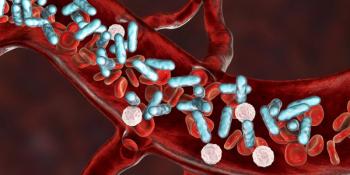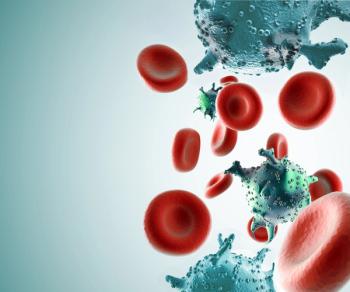
- Oncology Vol 30 No 4_Suppl_1
- Volume 30
- Issue 4_Suppl_1
(P041) Small Bowel Dose Tolerance in Stereotactic Body Radiation Therapy (SBRT) With Tumor Growth Inhibitors
Tumor growth factor inhibitors may cause more toxicity with SBRT than would otherwise be anticipated, although the absence of complications in our patients allows cautious optimism.
Tamara A. LaCouture, MD, Jinyu Xue, PhD, Gopal Subedi, MS, Qianyi Xu, PhD, Justin T. Lee, MD, Gregory J. Kubicek, MD, Jimm Grimm, PhD, Sucha O. Asbell, MD; MD Anderson Cancer Center at Cooper University Hospital; Holy Redeemer Hospital
PURPOSE AND OBJECTIVES: To estimate effects of tumor growth factor inhibitors on stereotactic body radiation therapy (SBRT) dose tolerance, we reviewed the literature and our patient experience.
METHODS: Review of the literature revealed the Barney et al dataset (Int J Radiat Oncol Biol Phys. 2013;87:73–80), which provided SBRT small bowel dose-volume histogram (DVH) data for D5cc, D2cc, Dmax, and other volumes, as well as the corresponding outcomes. Combining their data with ours yielded 175 small bowel contours, 54 managed with inhibitors of vascular endothelial growth factor (VEGF), epidermal growth factor receptor (EGFR), or mammalian target of rapamycin (mTOR) before or after SBRT, from May 2008 through December 2014. No patient in either institution received VEGF, EGFR, or mTOR inhibitors concurrently with SBRT; for our patients, we maintain a 2-week period between SBRT and biologic agents. All doses were first converted to three-fraction equivalent dose using the linear quadratic (LQ) model with alpha/beta = 3 Gy. DVH data were loaded into the DVH Evaluator software (DiversiLabs LLC, Huntingdon Valley, PA), which produced a probit dose-response model to estimate the risk level for each published dose tolerance limit.
RESULTS: Seven Common Terminology Criteria for Adverse Events version 4 grade 3–5 gastrointestinal toxicities were associated with VEGF in the published dataset. The probit dose-response model of 175 data points was used to estimate the risk level. In three fractions, the QUANTEC (Quantitative Analysis of Normal Tissue Effects in the the Clinic) Dmax ≤ 30 Gy limit had a 7% risk, and the TG101 Dmax ≤ 25.2 Gy limit had a 3.6% risk. A simple ratio approximated the increased risk from the inhibitors, as 7 of 54 cases with inhibitors and 7 of 175 overall cases had complications; therefore, the increased risk is approximately (7 of 54)/(7 of 175), for a 3.2-fold greater risk. However, none of the patients from our institution who were managed with VEGF, EGFR, or mTOR inhibitors had grade ≥ 3 complications.
CONCLUSION: Tumor growth factor inhibitors may cause more toxicity with SBRT than would otherwise be anticipated, although the absence of complications in our patients allows cautious optimism.
Proceedings of the 98th Annual Meeting of the American Radium Society -
Articles in this issue
Newsletter
Stay up to date on recent advances in the multidisciplinary approach to cancer.

















































































